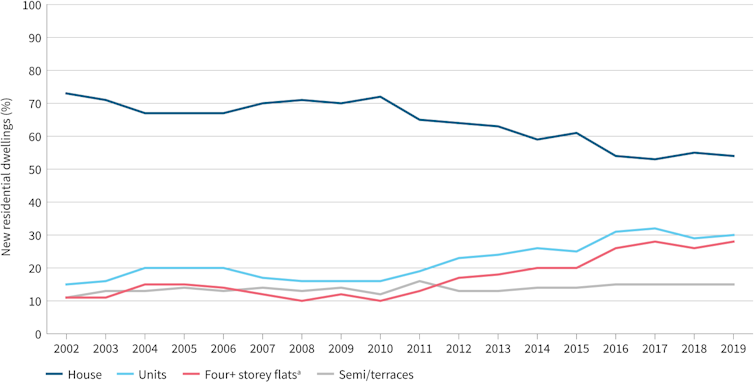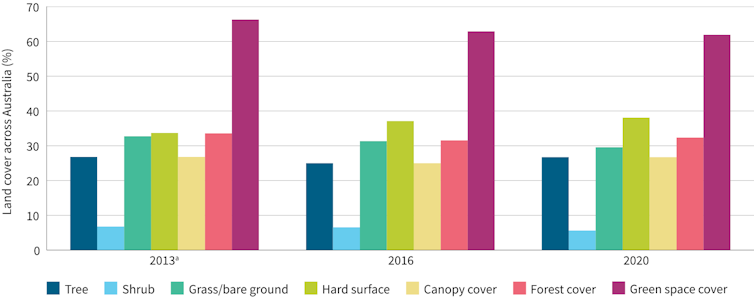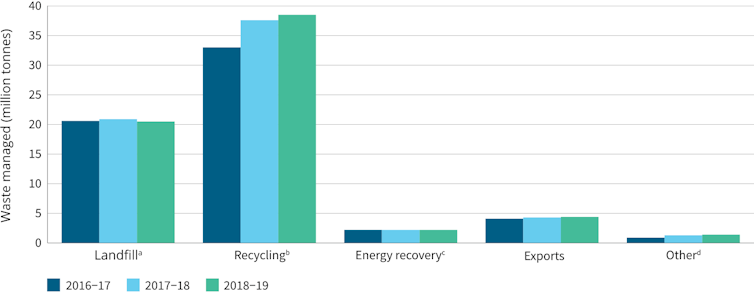The State of the Environment report shows our growing cities are under pressure – but we’re seeing positive signs too.
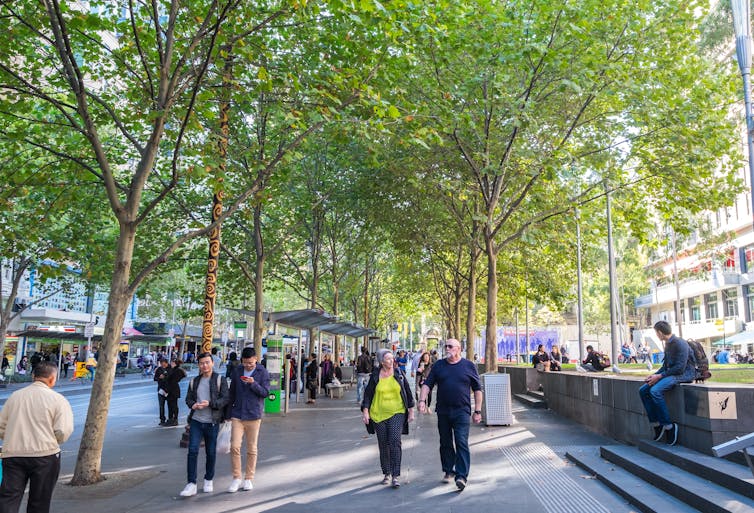
Shutterstock
Urban areas are often thought of as concrete jungles, but they encompass much more than that. Nature, people and built structures are interconnected. Together they comprise the urban environment of the cities and towns in which we live.
In the past five years, Australian cities have continued to grow. In fact, the State of the Environment Report released this week revealed most of our major cities have grown faster than many developed cities overseas.
This growth has increased demand for resources such as water and energy. It has increased other impacts, too, including urban heat, congestion, pollution and waste.
Australian energy consumption by fuel type, 1978–79 to 2018–19
Source: Urban chapter, Australia State of the Environment 2021 report/Commonwealth of Australia. Data: DISER 2020, CC BY
These pressures are a threat to the liveability and sustainability of urban life in Australia. However, the report assessed the overall state of the urban environment as good and stable – among the most positive ratings of any category. That’s largely a result of actions across Australia, mostly at the level of states, local councils and communities, that are starting to make progress towards cities that will be more resilient to climate change and remain good places for us to live.
The State of the Environment Report contains fundamental information on how the country’s environment is faring in areas ranging from air quality to urban environments. Western Parkland City Authority CEO Sarah Hill, private consultant and Barkandji woman Zena Cumpston and I collaborated in assessing the state of the urban environment for this report.
We found state and local governments have responded to some challenges with great initiatives that take us closer to more resilient and sustainable urban environments. However, there is still a need for national approaches and for better collaboration and co-ordination between the private and public sectors.
What are the pressures on our cities and towns?
The Australian Bureau of Statistics (ABS) defines urban as centres with more than 200 people. Australia has over 1,853 urban environments. However, 75% of people in Australia live in just 18 cities with more than 100,000 people each.
The report shows the population of these 18 urban areas grew by 20% in the past ten years. Most of that growth happened in the five years after the last State of the Environment report in 2016. At the same time, remote area populations decreased.
Property developers and the construction sectors have responded by increasing housing production. They have mainly focused on apartment buildings and semi-detached houses.
Trends in Australian new housing by type as a percentage of the total
Source: Urban chapter, Australia State of the Environment 2021 report/Commonwealth of Australia. Data: ABS 2021, CC BY
Unfortunately, at the same time the public sector has greatly reduced its role in housing. Based on ABS data, we calculated that the government now develops only 1% of all new dwellings in Australia.
Residential building and house sizes have slightly increased while lot sizes have shrunk. This means there is less open space. And these smaller backyards and setbacks between buildings are now often paved.
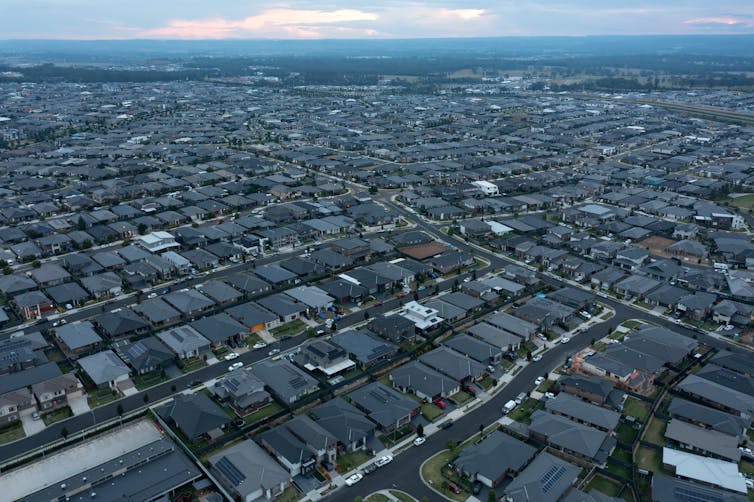
The trend towards larger homes on smaller blocks is having impacts on the urban environment. Shutterstock
As a result, we are seeing higher temperatures and reduced or endangered biodiversity. These changes have negative impacts on people’s and the environment’s well-being.
Despite local government policies to increase green cover in public areas and protect our urban forests, the changes in private properties have led to an overall loss of green spaces in our cities.
Trends in percentage of land cover by category across 131 local government areas
Source: Urban chapter, Australia State of the Environment 2021 report/Commonwealth of Australia. Data: Hurley et al, 2020, CC BY
These developments are often found in the urban outskirts of expanding cities. Increased travel distances and limited access to jobs, education, food and services are reducing the liveability of these cities.
These pressures are even worse in smaller and more isolated areas. For example, in the report we note:
“Indigenous communities in smaller urban centres are often far from amenities such as shopping, health care, cultural business, education and social services. In 2014-2015, 75% of Indigenous Australians reported that they could not easily get to the places they needed.”
These areas also have more insecure access to resources such as digital infrastructure, energy and water. On top of this, they have suffered from shocks such as extreme bushfires, floods and mice plagues.
So, the overall liveability of smaller urban areas with fewer than 10,000 people has been assessed as poor. The liveability of larger cities, on the other hand, has remained good over the past five years.
However, we need to beware of generalisations. Differences in liveability between inner and outer areas of the bigger cities are noticeable.
Inner-city areas have higher levels of liveability based on factors such as walkability, access to green spaces and services. The urban fringes tend to have poorer access to services and longer commute times. Higher socio-economic areas tend to benefit from better tree canopy cover and digital access.
Smaller urban areas have some advantages – mainly shorter commute times – but are disadvantaged by fewer services and job opportunities.
What are we doing about the challenges we face?
Population growth and its effects on resource consumption, waste generation, travel and pollution continue to pressure the urban environment. However, our biggest challenge is climate change.
Sea-level rises, more extreme events such as bushfires, drought, extreme rainfall and flooding, and higher urban temperatures are expected to have significant impacts on cities’ biodiversity and people.
Many state and local governments are taking a hands-on approach to some of these challenges and pressures. Through urban planning policies, they are managing urban sprawl and protecting public green areas.
Governments have also been investing in more integrated infrastructure – for example, better co-ordinating the development and use of roads, public transport, cyclepaths and walkways – better waste management and reducing disaster risk.
Commonwealth City Deals, the Resilient Cities Framework applied in Sydney and Melbourne, and the National Waste Policy Action Plan are just a few of the approaches being adopted in Australia.
Trends in waste management by category, 2016–17 to 2018–19
Source: Urban chapter, Australia State of the Environment 2021 report/Commonwealth of Australia. Data: ABS 2020, CC BY
We are on the right path with great initiatives all over Australia working to achieve more sustainable and resilient urban environments. However, they are in the early stages.
We do need more inter-agency and public-private collaboration. We need more community education, too. Policies can also be better implemented and followed up to continue improving management of the pressures on urban areas, which in turn will improve the well-being of people and the environment.
I would like to acknowledge Sarah Hill and Zena Cumpston, the co-authors of the State of the Environment Urban chapter. The joint work we did in the writing of the chapter informed this article.![]()
Gabriela Quintana Vigiola, Senior Lecturer in Planning, University of Technology Sydney
This article is republished from The Conversation under a Creative Commons license. Read the original article.



